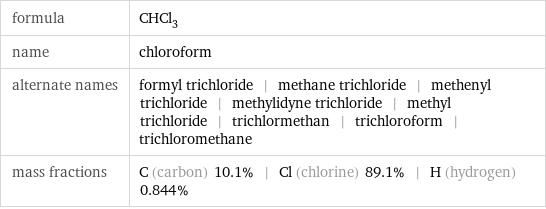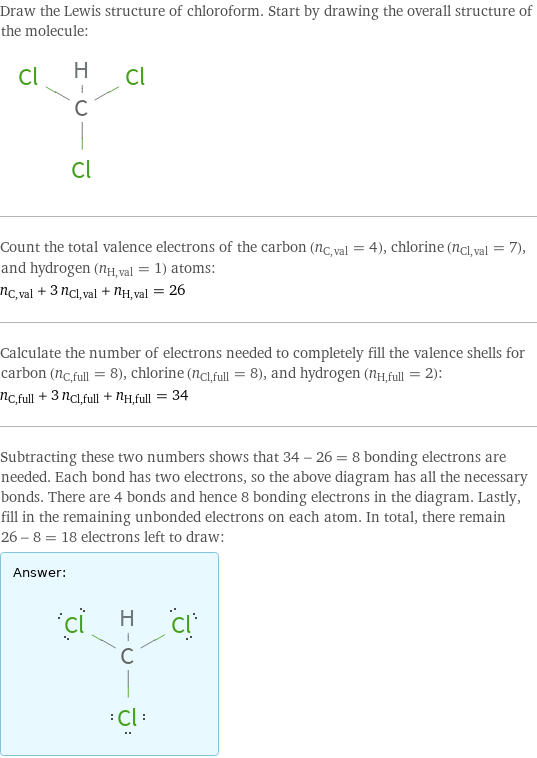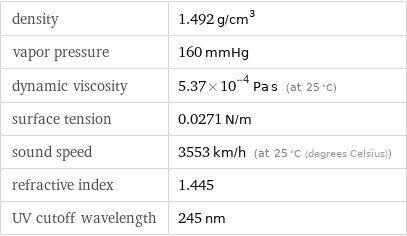Input interpretation

chloroform
Chemical names and formulas

formula | CHCl_3 name | chloroform alternate names | formyl trichloride | methane trichloride | methenyl trichloride | methylidyne trichloride | methyl trichloride | trichlormethan | trichloroform | trichloromethane mass fractions | C (carbon) 10.1% | Cl (chlorine) 89.1% | H (hydrogen) 0.844%
Lewis structure

Draw the Lewis structure of chloroform. Start by drawing the overall structure of the molecule: Count the total valence electrons of the carbon (n_C, val = 4), chlorine (n_Cl, val = 7), and hydrogen (n_H, val = 1) atoms: n_C, val + 3 n_Cl, val + n_H, val = 26 Calculate the number of electrons needed to completely fill the valence shells for carbon (n_C, full = 8), chlorine (n_Cl, full = 8), and hydrogen (n_H, full = 2): n_C, full + 3 n_Cl, full + n_H, full = 34 Subtracting these two numbers shows that 34 - 26 = 8 bonding electrons are needed. Each bond has two electrons, so the above diagram has all the necessary bonds. There are 4 bonds and hence 8 bonding electrons in the diagram. Lastly, fill in the remaining unbonded electrons on each atom. In total, there remain 26 - 8 = 18 electrons left to draw: Answer: | |
3D structure

3D structure
Basic properties

molar mass | 119.4 g/mol phase | liquid (at STP) melting point | -63 °C boiling point | 61 °C density | 1.492 g/cm^3 dielectric constant | 4.806
Liquid properties (at STP)

density | 1.492 g/cm^3 vapor pressure | 160 mmHg dynamic viscosity | 5.37×10^-4 Pa s (at 25 °C) surface tension | 0.0271 N/m sound speed | 3553 km/h (at 25 °C (degrees Celsius)) refractive index | 1.445 UV cutoff wavelength | 245 nm
Units

Thermodynamic properties

specific heat capacity c_p | gas | 0.5504 J/(g K) | liquid | 0.9567 J/(g K) molar heat capacity c_p | gas | 65.7 J/(mol K) | liquid | 114.2 J/(mol K) specific free energy of formation Δ_fG° | gas | 0.05026 kJ/g | liquid | -0.6174 kJ/g molar free energy of formation Δ_fG° | gas | 6 kJ/mol | liquid | -73.7 kJ/mol specific heat of formation Δ_fH° | gas | -0.8604 kJ/g molar heat of formation Δ_fH° | gas | -102.7 kJ/mol molar heat of vaporization | 15.9 kJ/mol | specific heat of vaporization | 0.133 kJ/g | molar heat of fusion | 9.5 kJ/mol | specific heat of fusion | 0.08 kJ/g | critical temperature | 537 K | critical pressure | 5.47 MPa | (at STP)
Chemical identifiers

CAS number | 67-66-3 Beilstein number | 1731042 PubChem CID number | 6212 PubChem SID number | 24848086 SMILES identifier | C(Cl)(Cl)Cl InChI identifier | InChI=1/CHCl3/c2-1(3)4/h1H RTECS number | FS9100000 MDL number | MFCD00000826
NFPA label

NFPA label

NFPA health rating | 2 NFPA fire rating | 0 NFPA reactivity rating | 0
Safety properties

flash point | -22 °C autoignition point | 982 °C upper explosive limit | 12.9% (concentration in air)

DOT hazard class | 6.1 DOT numbers | 1888
Toxicity properties

odor | pleasant odor threshold | 85 ppm lethal dosage | 908 mg/kg (oral dose for rats) short-term exposure limit | 225 mg/m^3 threshold limit value | 10 ppmv

probable lethal dose for man | 600 mL (milliliters) long-term exposure limit | 50 mg/m^3 (over 8 hours) RTECS classes | agricultural chemical and pesticide | tumorigen | drug | mutagen | reproductive effector | human data | primary irritant